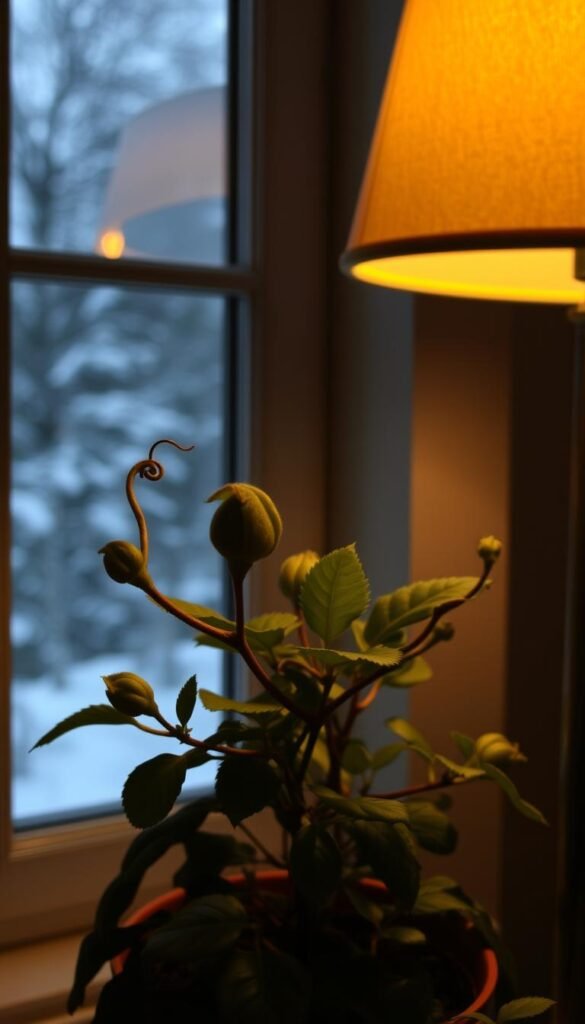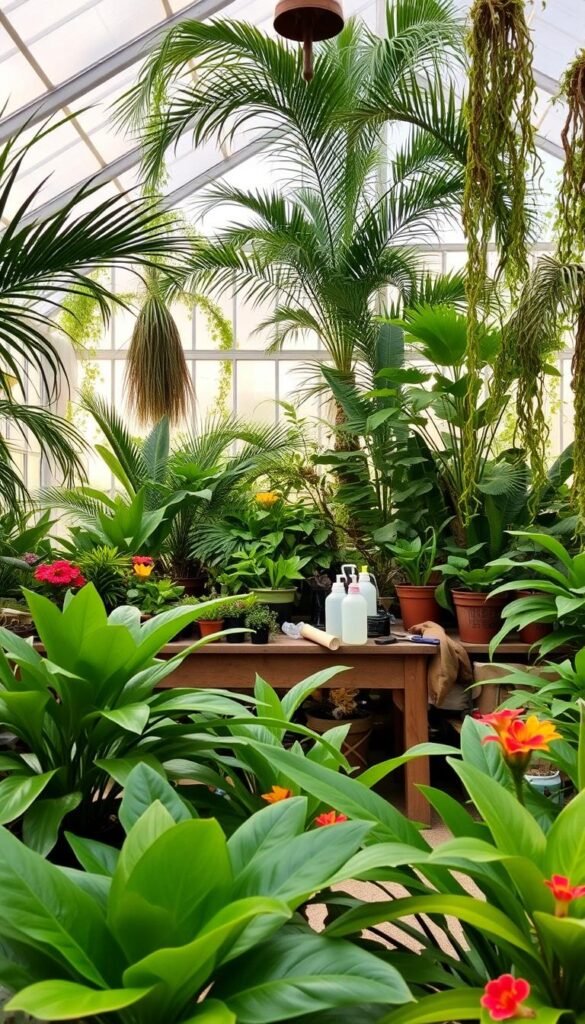Growing vibrant, heat-loving greenery in cooler climates requires careful planning. When temperatures drop, these exotic species face risks that native plants shrug off. You’ll need strategies to protect your investment through frosty nights and dry indoor air.
Many enthusiasts underestimate how sudden cold snaps affect delicate leaves and roots. Unlike hardy perennials, tropical varieties lack natural defenses against freezing conditions. Their survival often depends on your ability to mimic their preferred environment year-round.
Three key factors determine success: temperature control, moisture balance, and pest prevention. Ignore one, and the others suffer. For example, moving pots indoors might reduce frost damage—but cramped spaces can invite insects or mold.
Watch for warning signs like yellowing foliage or stunted growth. These often appear weeks before serious harm occurs. Early detection gives you time to adjust heating mats, humidifiers, or organic treatments.
Start preparing in late summer. This head start lets you test solutions while weather remains forgiving. With the right approach, your prized specimens can thrive through every season.
Tropical Fruit Garden Challenges: Overwintering, Watering, and Pest Issues

Seasonal changes demand different strategies for keeping sensitive greenery healthy. While native species adapt naturally, imported varieties need your attention when mercury dips below 50°F. Let’s explore how to spot trouble before it becomes irreversible.
Weather Patterns and Plant Responses
Most non-native species show stress when nighttime temperatures consistently fall below 40°F. Young plants with thin stems often suffer first. Watch for curling edges on leaves – this early warning signals your green friends need help.
Spotting High-Risk Specimens
Three factors increase cold sensitivity:
- Shallow roots that can’t access deeper soil warmth
- Juvenile growth with underdeveloped protective layers
- Broad foliage that loses heat rapidly after sunset
| Plant Type | Safe Temp Range | Recovery Time | Protection Needs |
|---|---|---|---|
| Tender Perennials | 45°F+ | 2-3 weeks | High |
| Woody Shrubs | 35°F+ | 1-2 weeks | Moderate |
| Mature Trees | 28°F+ | 3-5 days | Low |
Zone 9 gardeners face unique challenges – brief frost events can damage foliage while roots remain safe. Time interventions using local fall weather patterns as your guide. Remember: Healthy plants entering winter handle stress better than weakened ones.
Preparing Your Tropical Garden for Winter
Late September marks the golden hour for safeguarding your sun-loving specimens. This sweet spot between summer’s warmth and autumn’s chill lets you address vulnerabilities before they escalate. Strategic care now prevents costly replacements next spring.
Trimming and Inspecting for Pests
Start by removing dead stems and yellow leaves. These attract harmful insects and drain energy from healthy growth. Use clean shears to make angled cuts just above leaf nodes.
Check leaf undersides for egg clusters. A magnifying glass helps spot tiny threats like spider mites. For soil-dwellers, try this trick: Place a damp newspaper on potting mix overnight. Lift it in the morning to reveal hiding slugs.
Choosing the Right Storage Methods
Active tropicals need bright spaces. Position them 6-12″ below fluorescent lights for 10 hours daily. Dormant types prefer dark corners with 45-55°F temperatures.
| Storage Type | Light Needs | Temp Range | Water Frequency |
|---|---|---|---|
| Growing Plants | Medium | 65-75°F | Weekly |
| Dormant Specimens | None | 45-55°F | Monthly |
| Propagation Cuttings | Low | 70-80°F | Mist Daily |
Multiply prized tropicals through September cuttings. Snip 4″ stem sections, dip in rooting hormone, and plant in vermiculite. This bypasses the need to buy mature plants each year.
Effective Watering Strategies for Cold Conditions
Hydration becomes your secret weapon during chilly months. Proper moisture management shields roots from temperature swings while supporting vital functions. Let’s explore three techniques that work together like a thermostat for your green companions.
Deep Watering to Protect Roots
Soak the ground thoroughly before freezing nights arrive. Moisture penetrates deeper layers, creating a thermal blanket around root zones. Target the drip line – where rainwater naturally falls from leaves. This area holds the most active feeder roots needing protection.
Mulching for Moisture Retention
A 3-inch layer of organic material locks in warmth and slows evaporation. Pine straw and shredded bark allow airflow while preventing ice formation. Avoid piling mulch against stems – leave a 2-inch gap to deter rot.
| Mulch Type | Insulation Value | Application Depth |
|---|---|---|
| Straw | High | 4-6 inches |
| Bark Chips | Medium | 3 inches |
| Leaf Mold | Low | 2 inches |
Timing Watering Practices with Frost Events
Water by 10 AM on days when frost threatens. This gives liquid time to soak in before temperatures drop. Never irrigate when thermometers read below 40°F – ice crystals can rupture delicate root cells. Check forecasts weekly to sync your schedule with nature’s patterns.
Managing Winter Pests and Disease Risks
Cold weather invites unwelcome guests to your indoor greenery. Hidden hitchhikers thrive in cozy storage spaces, turning protected areas into breeding grounds. A three-step defense system keeps your collection safe: sanitation, airflow management, and regular checkups.
Identifying Common Pest Threats
Watch for sticky residue on leaves – a telltale sign of aphids. Spider mites create fine webs between stems, while scale insects resemble tiny brown bumps on foliage. These invaders multiply quickly in stagnant air.
| Pest | Visible Signs | Favorite Plants | Treatment |
|---|---|---|---|
| Aphids | Curled new growth | Young shoots | Neem oil spray |
| Spider Mites | Yellow speckles | Dry environments | Insecticidal soap |
| Scale | Hard shells | Woody stems | Alcohol swabs |
Implementing Preventative Treatments
Set weekly reminders to wipe leaves with diluted lemon juice. This simple hack removes dust and discourages egg-laying. Position an oscillating fan 4 feet from your compact citrus varieties to maintain air circulation without drying soil.
Quarantine new arrivals for 14 days – most pests show themselves within this window. For persistent issues, introduce ladybugs to your storage area. These natural predators devour 50+ aphids daily.
| Prevention Method | Frequency | Effectiveness |
|---|---|---|
| Leaf inspections | Biweekly | 90% early detection |
| Sticky traps | Monthly | 75% fly reduction |
| Beneficial nematodes | Seasonal | Soil pest control |
Enhancing Indoor Overwintering Success
Transforming spare rooms into temporary plant havens keeps sensitive specimens thriving through frosty months. Strategic lighting setups prevent energy drain while maintaining dormancy rhythms. Here’s how to balance affordability with effectiveness for your green companions.
Smart Lighting Solutions
Standard 75-watt fluorescent tubes work wonders when hung 12-18″ above foliage. Chain suspensions let you adjust height as plants grow. Pair these with outlet timers for consistent 10-hour light cycles – enough to sustain without triggering new shoots.
| Setup Type | Light Duration | Space Use | Benefits |
|---|---|---|---|
| Floor Placement | 8-10 hours/day | Large specimens | Direct overhead coverage |
| Tabletop Setup | 12 hours/day | Compact varieties | Even distribution |
| Hanging Lights | 10 hours/day | Vertical space | Adjustable height |
Rotate pots weekly to ensure all sides receive equal exposure. This prevents lopsided growth and maintains structural integrity. Combine with proper winter care techniques for optimal results.
Airflow matters as much as illumination. Position oscillating fans 4-6 feet away to mimic outdoor breezes. This simple trick reduces fungal risks while strengthening stems. Monitor humidity with cheap hygrometers – aim for 40-50% to match most tropicals’ preferences.
Come spring, your preserved collection will rebound faster than replacements. These space-saving strategies let you protect prized specimens without remodeling your home. Remember: Consistency beats intensity when maintaining winter routines.
Wrapping Up Your Tropical Winter Care Journey
As daylight stretches in February, your green companions sense the shift. Dormant stems awaken with tender buds, while soil whispers promises of spring renewal. This natural rhythm rewards those who master winter’s delicate dance.
Hold off moving specimens outdoors until night temps stay above 50°F. Begin with hourly outdoor sessions in April, gradually increasing exposure. Your patience pays off when plants burst into vigorous growth come May.
Resist the urge to overwater during these final indoor months. Let soil dry slightly between drinks – this prevents root rot while mimicking natural dry spells. Focus instead on rotating pots for even light distribution.
Successful overwintering brings dual benefits: mature specimens create instant garden drama, while saved costs fund new cuttings. Each surviving plant becomes a living trophy of your nurturing skills. Soon, summer’s warmth will celebrate your winter wisdom.






